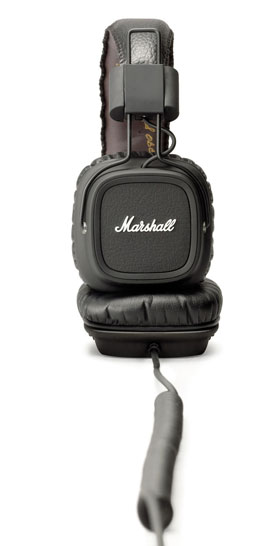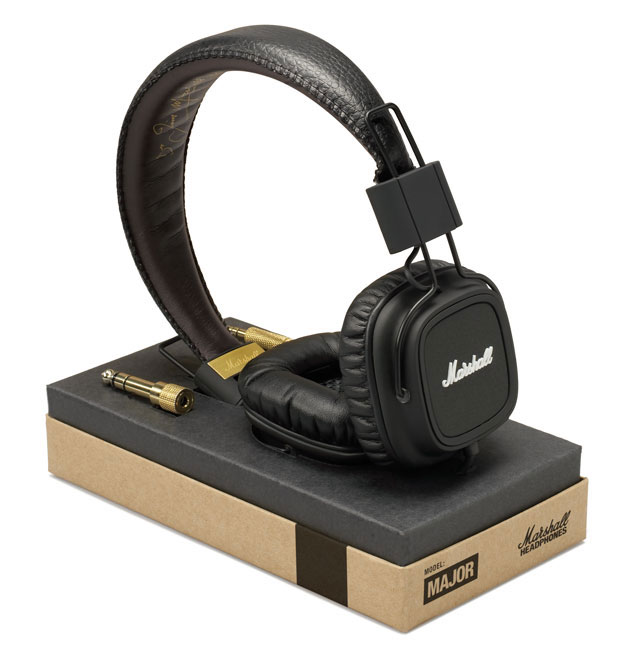 The headphones market has grown enormously in recent years, with just about every big electronics manufacturer offering high-end cans, and various newcomers springing up to sell headphones exclusively.
The headphones market has grown enormously in recent years, with just about every big electronics manufacturer offering high-end cans, and various newcomers springing up to sell headphones exclusively.
Amplifier maker Marshall has entered the fray with a range of over-the-ear and in-ear headphones that, thankfully, don’t simply seek to cash in on a famous brand name.
We reviewed a pair of headphones from the over-the-ear “Major” range — as opposed to the in-ear “Minor” range — and the first thing we noticed was how comfortable they are.
Marshall claims the headphones are “designed with non-stop, all-day listening in mind” and it shows — the padded ear cups are not only incredibly easy on the ears but do a great job of cancelling external noise while simultaneously limiting the degree to which your choice in music is inflicted on those around you.
From the packaging to the headphones themselves, the minimalist Marshall aesthetic is evident throughout — the ear cups are square and adorned only with the Marshall logo, the headband is made of the same vinyl as the company’s amplifier cabinets and carries founder Jim Marshall’s signature on the inside, and aside from the remote on the cable there’s little to indicate whether the headphones were made last year, or last century.
In keeping with offerings from contemporaries, the Marshall Majors offer a single-button remote and microphone for use with mobile phones and tablets. One press of the button answers or ends a call, or plays or pauses the playing track. Two presses skips forward a track and three skips backwards. It’s a simple and elegant solution, and although the microphone is a little softer than those found in modern smartphones, it’s perfectly sufficient for phone calls.
Despite their name, the Majors are actually surprisingly compact and the hinges above the ear cups allow them to fold up for easy storage or transportation. There’s no supplied hard or soft case for the purpose, but then, unless there are lots of adapters and accessories, there’s little need for one.
As far as adapters go, the Majors come with only two: a 6,3mm jack adapter — it comes with a 3,5mm jack as standard — and a “neutral stereo plug adapter”, which offers a 90 degree connection rather than the straight, standard 3,5mm jack on the end of the cable. This is meant to cancel out interference from phones.
The cable itself includes a spiral portion of the sort found on desktop telephones and the end has a spring before the connector intended to increase the durability of the cable. The result is it looks like the sort of cable you might plug into an amp.

At around 1m (without stretching the coiled portion) the cable is a great length if you’re connecting the headphones to a tablet on your lap or a phone in your pocket, but it’s a little short if you intend using them with a desktop computer, particularly if the machine isn’t on your desk.
It should come as little surprise that the Majors sound almost as good as they look. Bass is booming and rich and mid-tones are really well rounded. The highs are crisp without being abrasive and the headphones sound surprisingly good, even at low volume. Of course, crank them up a little and they really come into their own.
Some might find the treble a little too gentle compared to the bass and may wish to adjust this using an equaliser, but we found the Majors sounded excellent straight out of the box, particularly with rock music and bass-heavy hip hop.
Marshall’s Majors may not be able to match the audio quality of the best pair of Beats or Sennheisers, but then, at R999, they shouldn’t be expected to.
The Majors aren’t designed for audiophiles or audio professionals. Rather, they’re designed for music fans looking for comfortable, capable cans that won’t break the bank. They look great and they sound great, and that’s pretty much what it says on the box.
Jim Marshall, the man behind the iconic amplifier company, died in April, around the time the first Marshall headphones hit the market. Are they fitting of his legacy? Absolutely. — (c) 2012 NewsCentral Media



